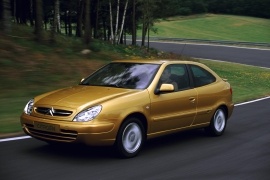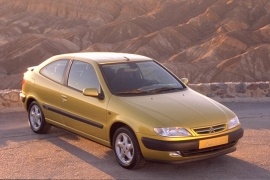CITROEN Xsara Coupe Models/Series Timeline, Specifications & Photos
First production year: 1998
Engines: Diesel, Gasoline
Body style: Coupé (two-door)
It was Citroen's big motorsport revolution in a compact-coupe form that led to a highly competitive rally-car. Unfortunately, the Xsara VTS was way too underrated for its abilities.
Citroen introduced the Xsara lineup in 1997, and it facelifted it four years later. Along with the rest of the range, the carmaker changed the Coupe version. In 1999, a 2WS Xsara kit-car rocked the all-wheel-drive vehicle supremacy in two rallies, and the car became notorious. Its 2.0-liter naturally aspirated engine was a masterpiece, and, most of all, it was quicker and faster than the Golf IV GTI.
While the non-facelifted version featured horizontal, small headlights, Citroen installed new headlights swept-back over the fenders to improve the night-time driving. The designers made room for a wider grille in the front bumper to enhance both the cooling and the car's look. From its sides, the car retained the same coupe profile with body-colored moldings.
Inside, the Xsara VTS kept the same interior with either wood or aluminum trims. The front seats were high bolstered with good grip on the sides to keep its occupants in place during hard cornering. In the back, the split-folding bench helped increase the trunk size. The car's profile was closer to a coupe, but it featured a tailgate in the back, so it was between a coupe and a hot-hatch.
Under the hood, the Xsara Coupe featured a choice of three engines, both diesel, and gasoline. Citroen fitted the sportiest version with a 2.0-liter, 16-valves engine paired as standard to a 5-speed manual gearbox.
Citroen introduced the Xsara in 1997 and, in the following year, it offered the Coupe version, which showed a two-door style in a hatchback bodywork.
Citroen designers were not satisfied with a two-door version of an Xsara. They worked harder to create a coupe-looking hatchback and then push the marketing department to approve it for production. In the end, in 1998, the French carmaker unveiled the car, and the sales jumped up immediately. Moreover, the car's presence in the World Rally Championship increased the company image. It even won two WRC events in 1999, even though it was only two-wheel-drive and not all-wheel-drive like the WRCars.
Even though it shared the same name as the five-door Xsara, it didn't share too many body panels with that. Apart from the same platform and the similar front fascia, it was a different car. It was even available with specific engines in the VTS version. Its raked windshield and the hunchback greenhouse looked different. In the rear, the Xsara Coupe featured a tailgate in a Kamm-back design.
Inside, the carmaker offered the coupe with different styles and options. From the base, cloth-upholstered interior to the full-option version fitted with Alcantara, Citroen didn't cut corners and let the customers decide what they wanted for their budget. Unlike other coupes on the market, there was good interior room for four adults. Two people could sit in the back on the 60/40 split-folding bench.
Under the hood, Citroen offered the Xsara a choice of gasoline and turbo-diesel version that covered most of the customers' needs for a compact-sized coupe.
Citroen introduced the Xsara lineup in 1997 as its new contender in the compact segment, and in the following year, it unveiled the coupe-shaped VTS version that aimed at the hearts of young customers looking for exciting vehicles.
Citroen introduced the Xsara VTS as a sporty-looking hatchback, but unlike other three-door competitors, it featured a shape that resembled a coupe, not a station wagon. Moreover, besides the sporty look, the car was also fitted with a wide choice of engines for every pocket and for every need. Thus, Citroen tried to seize a larger slice of the compact segment. Unfortunately for the French automaker, customers didn't storm showrooms despite the car's great styling.
Unlike the German automakers, who preferred the form-follow-function principle in building cars, Citroen went for the function-follow-form idea when it penned the Xsara Coupe VTS. But still, the automaker had to keep the car on a budget. As a result, some parts of the vehicle were shared with its five-door sibling.
At the front, the narrow, organic-shaped headlights were swept back around the corners and featured clear turn signals. The upper grille, mounted above the bumper, sported a horizontal slat where the brand's logo took center stage. A black, fat, rubber element protected the bumper against small bumps in the parking lot, while the lower apron got an additional air intake flanked by a pair of fog lamps when optioned.
But the car's profile was the one that sparked customers' imagination. The slightly ascending waistline with black trims was extended towards the C-pillars. A sloped-down tailgate ended the car and sported a small spoiler.
Citroen created a user-friendly interior with cloth upholstery. Depending on the trim level and engine version, the Xsara VTS featured a pair of bucket seats or sports seats with high-bolstered areas. The driver fronted an instrument cluster filled with two large dials for the speedometer and tachometer in the middle and the fuel level and water temperature that flanked them.
Citroen created the Xsara lineup at the heights of the bio-design era, so the VTS version carried over those principles. As a result, the interior lines were mostly rounded, with a center stack that continued the instrument panel's visor. It housed the controls for the HVAC system and the stereo. In the back, the automaker installed a narrow bench seat with a split-folding seatback. There, two adult-sized passengers could sit for short trips in and around town.
Under the hood, Citroen installed a choice of diesel and gasoline engines that ranged between 90 PS (89 hp) and 167 PS (165 hp). All versions were paired with a five-speed manual gearbox that sent the power to the front wheels only.
The car's platform was praised for its qualities and road-holding capabilities, being able to tackle tight corners at higher speed than most other compact-sized vehicles on the market.


